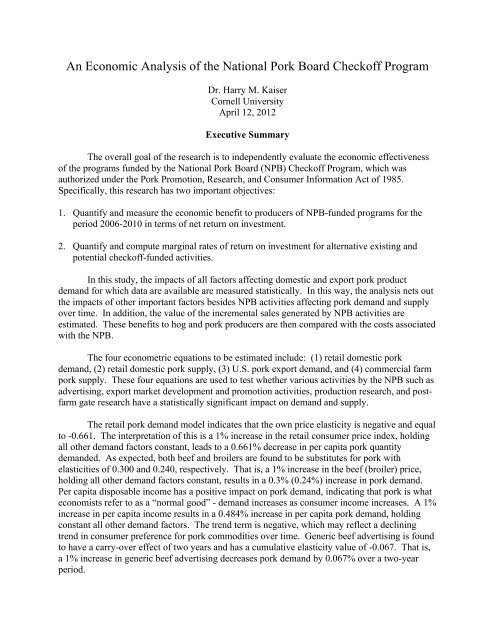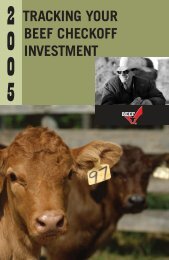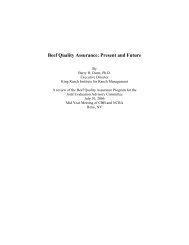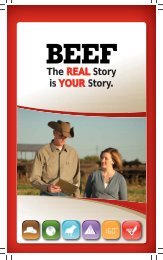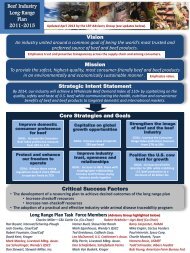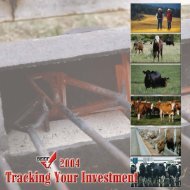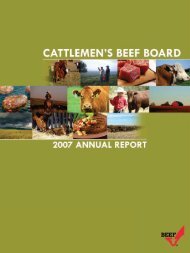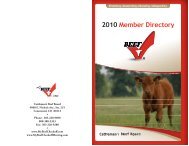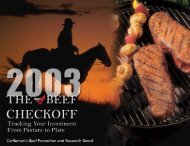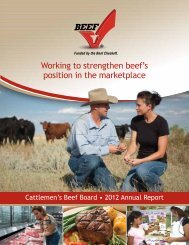2011 ROI Full Report - National Pork Board
2011 ROI Full Report - National Pork Board
2011 ROI Full Report - National Pork Board
Create successful ePaper yourself
Turn your PDF publications into a flip-book with our unique Google optimized e-Paper software.
An Economic Analysis of the <strong>National</strong> <strong>Pork</strong> <strong>Board</strong> Checkoff ProgramDr. Harry M. KaiserCornell UniversityApril 12, 2012Executive SummaryThe overall goal of the research is to independently evaluate the economic effectivenessof the programs funded by the <strong>National</strong> <strong>Pork</strong> <strong>Board</strong> (NPB) Checkoff Program, which wasauthorized under the <strong>Pork</strong> Promotion, Research, and Consumer Information Act of 1985.Specifically, this research has two important objectives:1. Quantify and measure the economic benefit to producers of NPB-funded programs for theperiod 2006-2010 in terms of net return on investment.2. Quantify and compute marginal rates of return on investment for alternative existing andpotential checkoff-funded activities.In this study, the impacts of all factors affecting domestic and export pork productdemand for which data are available are measured statistically. In this way, the analysis nets outthe impacts of other important factors besides NPB activities affecting pork demand and supplyover time. In addition, the value of the incremental sales generated by NPB activities areestimated. These benefits to hog and pork producers are then compared with the costs associatedwith the NPB.The four econometric equations to be estimated include: (1) retail domestic porkdemand, (2) retail domestic pork supply, (3) U.S. pork export demand, and (4) commercial farmpork supply. These four equations are used to test whether various activities by the NPB such asadvertising, export market development and promotion activities, production research, and postfarmgate research have a statistically significant impact on demand and supply.The retail pork demand model indicates that the own price elasticity is negative and equalto -0.661. The interpretation of this is a 1% increase in the retail consumer price index, holdingall other demand factors constant, leads to a 0.661% decrease in per capita pork quantitydemanded. As expected, both beef and broilers are found to be substitutes for pork withelasticities of 0.300 and 0.240, respectively. That is, a 1% increase in the beef (broiler) price,holding all other demand factors constant, results in a 0.3% (0.24%) increase in pork demand.Per capita disposable income has a positive impact on pork demand, indicating that pork is whateconomists refer to as a “normal good” - demand increases as consumer income increases. A 1%increase in per capita income results in a 0.484% increase in per capita pork demand, holdingconstant all other demand factors. The trend term is negative, which may reflect a decliningtrend in consumer preference for pork commodities over time. Generic beef advertising is foundto have a carry-over effect of two years and has a cumulative elasticity value of -0.067. That is,a 1% increase in generic beef advertising decreases pork demand by 0.067% over a two-yearperiod.
2The statistical results indicate that all three pork checkoff program demand enhancingactivities have a positive and statistically significant impact on increasing per capita porkdemand. Generic pork advertising has a two-year carry over effect with a cumulative elasticityof 0.109. The estimated non-advertising promotion elasticity is 0.046 meaning a 1% increase inpork promotion expenditures results in a 0.046% increase in per capita pork demand. Finally,demand enhancing pork research is found to have a lagged effect from two to seven years withthe largest effects occurring in years 3 and 4. Cumulatively, a 1% increase in demand enhancingresearch increases per capita pork demand by 0.006% holding all other factors constant. Becausethere is error inherent in any statistical model, a 90% confidence interval is computed for thethree pork checkoff program elasticities. This interval can be interpreted as the range of possiblevalues where one can be confident that the true population elasticity could be expected to fall90% of the time. The 90% confidence interval for the generic pork advertising elasticity is(0.057, 0.174). The 90% confidence interval for the generic non-advertising promotion elasticityis (0.014, 0.087). The 90% confidence interval for the demand enhancing research elasticity is(0.0034, 0.0094).The retail pork supply model indicates that the own price elasticity is 0.203. That is,holding all other supply factors constant, a 1% increase in the retail pork price results in a0.203% increase in quantity supplied by pork retailers. By construction of the model, the impactof the hog price on retail pork supply is the exact opposite of the retail price impact, i.e., a 1%increase in the hog price results in a 0.203% decrease in retail pork supply, reflecting that thehog price is a cost to pork retailers. The trend variable is positive and statistically significant,which has had a positive impact on retail pork supply.Based on the export demand model, the value of the U.S. dollar has the most importantimpact on export demand. The elasticity estimate is -2.682 indicating a 1% increase in the valueof the U.S. dollar decreases exports of U.S. pork by 2.682%, holding all other demanddeterminants constant. The prices of U.S. and rest-of-the world pork are also significant factorsin explaining annual variations in exports of U.S. pork. The estimated own-price elasticity is -1.574 indicating that a 1% increase in the U.S. pork price decreases U.S. pork exports by1.574%. The elasticity of exports of U.S. pork with respect to rest-of-the-world (ROW) prices is0.664. World Gross Domestic Product (GDP) net of U.S. GDP is positive indicating that U.S.pork is a normal good. A 1% increase in world GDP results in a 1.425% increase in exports ofU.S.The statistical results indicate that U.S foreign market development programs have theeffect of increasing the export demand for U.S. pork. The model indicates that there is a threeyearcarry-over effect of foreign market development. That is, current as well as three years oflagged foreign market development expenditures impact U.S. pork exports. The estimatedresults indicate that a 1% increase in foreign market development expenditures increase U.S.pork exports by 0.302%. The 90% confidence interval for the elasticity is (0.217, 0.442).In the hog supply model, the own-price elasticity is equal to 0.296, i.e., a 1% increase inprice, holding all other supply factors constant, results in a 0.296% increase in hog quantitysupplied after allowing for a three-year adjustment period. The elasticity of hog supply with
3respect to total production costs is -0.165. That is, a 1% increase in costs this year results in a0.165% decrease in hog supply next year. The coefficient on the trend term is positive andmarginally statistically significant indicating improvements in technology and managerial abilityover time.The statistical results indicate that NPB-sponsored production-level research has apositive and statistically significant impact on hog supply. The elasticity for production researchis 0.025. That is, a 1% increase in research expenditures results in a 0.025% increase in hogsupply over four-years. The 90% confidence interval for the long-run elasticity is (0.006, 0.044).A simulation model, based on the estimated elasticities from the econometric model isconstructed and simulated for the most recent 5-year period, 2006-2010. Based on thesimulation results, it is clear that the NPB activities have impacted both prices and quantities inthe market over this period. Generic pork advertising is found to have the largest impact on thefarm-level hog price, a 1% increase in advertising increases the hog price by $0.0073 per cwt.,holding all other factors constant. Domestic promotion, export promotion, and demandenhancingresearch also increase the hog price, but not as much as advertising. Specifically, a1% increase in domestic promotion increased the hog price by $0.0031 per cwt., a 1% increase inexport promotion increases the hog price by $0.0051 per cwt., and a 1% increase in demandenhancingresearch increases the hog price by $0.0004 per cwt. Since farm production researchincreases supply, it has the impact of reducing the hog price. A 1% increase in this activitydecreases the hog price by $0.0317 per cwt. holding constant all other factors. Collectively, a1% increase in all five activities results in a $0.0158 per cwt. decrease, holding all other factorsconstant, indicating the negative effects of production research outweigh the positive effects ofthe other four factors on price.All five NPB activities have positive impacts on farm-level supply. As expected, farmproduction research has the largest impact on supply. On average over this period, a 1% increasein NPB-sponsored production research increases farm supply by 2 million pounds per year,holding all other variables constant. A 1% increase in generic pork advertising increases supplyby 818,386 pounds per year. The other three NPB activities also have a positive, butsignificantly smaller impact on farm supply. A 1% increase in all five NPB activities combinedincreases farm supply by almost 3.5 million pounds per year. All five NPB activities benefit hogproducers in terms of increasing producer surplus. Even though farm production researchdecreases the hog price, it has the largest positive impact on producer surplus of all fiveactivities. A 1% increase in farm production research increases producer surplus by $7 millionper year, holding all other factors constant. Generic pork advertising has the next highest impacton producer surplus. A 1% increase in pork advertising results in a $1.6 million per yearincrease in producer surplus. A 1% increase in non-advertising promotion results in a $687,216per year increase in producer surplus. A 1% increase in foreign market development increasesproducer surplus by $514,302 per year, and a 1% increase in demand-enhancing researchincreases producer surplus by $89,636 per year.The highest marginal benefit-cost ratio (BCR), which is sometimes called a return oninvestment, is for production research. An extra dollar invested in production research yields$52.40 in producer surplus. The next highest return is for foreign market development, where an
4extra dollar invested yields $19.10 in producer surplus. Generic pork advertising has a marginalBCR of 18.0. Finally, non-advertising promotion and demand enhancing research have marginalBCRs of 2.6 and 3.0, respectively. Collectively, the overall marginal BCR for all five activitiesis $17.4 for an additional dollar invested in the NPB.All of these figures presented are “point estimates,” which are estimates rather than exactmeasures. That is, there is uncertainty about the precision of these estimates and therefore it isuseful to construct confidence intervals around these point estimates. The confidence intervalsgive a lower and upper bound to the point estimate where one can be reasonable confidant thatthe true measurement lies. It is especially important to estimate the lower bound confidenceinterval for the BCR. The lower bound of the 90% confidence interval for the marginal BCR forall five NPB activities combined is 8.0, which is well above 1.0. Hence, one can be reasonableassured that an extra dollar invested in the NPB would return greater than one dollar in producersurplus to the industry. In fact, all the NPB, except non-advertising promotion, have lowerbound marginal BCRs greater than 1.0. This finding gives credence to the conclusion that theNPB has been profitable to hog producers over this period.
5An Economic Analysis of the <strong>National</strong> <strong>Pork</strong> <strong>Board</strong> Checkoff ProgramThe <strong>National</strong> <strong>Pork</strong> <strong>Board</strong>’s (NPB) central mission is to increase the demand for hogs andpork products, reduce production costs, and improve the profitability of hog and pork producers.The program is funded by a mandatory assessment on U.S. hog producers and importers of hogsand pork products. Under existing agricultural legislation, the NPB is required to have anindependent analysis of the economic effectiveness of the program conducted at least once everyfive years. Accordingly, the purpose of the research reported here is to conduct such aneconomic evaluation for the most recent period of performance for the NPB, 2006-2010.The overall goal of the research is to independently evaluate the economic effectiveness of theprograms funded by the <strong>Pork</strong> Promotion, Research, and Consumer Information Act of 1985.Specifically, this research has two important objectives: (1) quantify and measure the economicbenefit to producers of NPB-funded programs for the period 2006-2010 in terms of net return oninvestment; and (2) quantify and compute marginal rates of return on investment for alternativeexisting and potential checkoff-funded activities.In this study, the impacts of all factors affecting domestic and export pork productdemand for which data are available are measured statistically. In this way, the analysis nets outthe impacts of other important factors besides NPB activities affecting pork demand and supplyover time. In addition, the value of the incremental sales generated by NPB activities areestimated. These benefits to hog and pork producers are then compared with the costs associatedwith the NPB.This independent evaluation is carried out by Dr. Harry M. Kaiser, who is the Gellert FamilyProfessor of Applied Economics and Management at Cornell University. Dr. Kaiser is a nationaland internationally renowned expert in the economics of generic advertising and promotion
6programs. Dr. Kaiser has extensive experience in doing over 100 economic evaluation studies ofdomestic and international checkoff programs. In fact, he has conducted eight studies in the pastone-and-one-half years alone, including: (1) <strong>2011</strong> economic evaluation of the U.S. Meat ExportFederation export promotion activities, (2) <strong>2011</strong> evaluation of the national dairy farmer checkoffprogram (COP), (3) <strong>2011</strong> evaluation of the national fluid processor COP, (4) <strong>2011</strong> evaluation ofdomestic generic raisin promotion, (5) 2010 evaluation of raisin export promotion, (6) 2010evaluation on the Highbush Blueberry Marketing Council’s promotion activities, (7) 2010evaluation of U.S. wheat export promotion, and (8) 2010 evaluation of the New York State fluidmilk promotion order.<strong>National</strong> <strong>Pork</strong> <strong>Board</strong> Program ExpendituresThe NPB was implemented in 1986 and is designed to increase the overall demand (bothdomestic and foreign) for U.S. hogs and pork products, decrease farm production costs, improvefarm efficiency, and improve the overall profitability of hog and pork production. The NPB isfunded by a mandatory assessment of 0.4% of the market value of all hogs sold in the UnitedStates. In addition, this program collects assessments on hogs and pork products from foreignmarkets imported into the United States. Collectively, this program raises around $60 million onan annual basis.The NPB invests in a variety of activities to accomplish its overall objectives ofimproving profitability for the hog and pork sectors. In this report, these activities are dividedinto five broad categories:- Domestic media advertising,- Domestic non-advertising promotion,
7- Foreign market development,- Farm-level, production research, and- <strong>Pork</strong> product, “demand-enhancing” research.Figure 1 illustrates the percent of the 2010 NPB budget spent on each of these activities.In 2010, non-advertising promotion expenditures was the largest category of the NPB budget,accounting for 51% of the spending. This was followed in importance by production-levelresearch (21%) and generic advertising (14%). NPB contributions to foreign marketdevelopment expenditures represented 10% of the 2010 budget, while pork product researchcomprised 4%. The relative magnitudes of these five activities have varied, considerably, overtime.Domestic generic pork advertising once accounted for the majority of the NPBexpenditures. Figure 2 displays generic pork advertising from 1987 through 2010 in real,inflation-adjusted (2010) dollars. These expenditures are devoted to all domestic mediaadvertising such as television, radio, print, outdoor, and web advertising. It is clear from thisgraph that the NPB relies less on generic advertising as a demand enhancing strategy today thanit did when the program began in 1987. For example, $14.3 million (in 2010 dollars) was spenton generic advertising expenditures in 1987 vs. $6.6 million in 2010, which represents a 54%decline.Figure 3 presents generic non-advertising promotion expenditures over this time period,which include all non-media demand enhancing activities such as merchandising, food servicemarketing, consumer research, and consumer public relations. Over time, the NPB has divertedexpenditures from advertising and put those dollars into non-advertising promotion
8Figure 1. Percent of NPB expenditures by majoractivity in 2010.AdvertisingPromotionForeign marketdevelopmentProduction researchDemand-enhancingresearch25.00Figure 2. Real, inflation-adjusted generic porkadvertising expenditures.20.00Million dollars15.0010.005.000.00198719881989199019911992199319941995199619971998199920002001200220032004200520062007200820092010Year
9Million dollars35.0030.0025.0020.0015.0010.005.00Figure 3. Real, inflation adjusted generic pork nonadvertisingpromotion expenditures.0.00198719881989199019911992199319941995199619971998199920002001200220032004200520062007200820092010YearMillion dollars18.0016.0014.0012.0010.008.006.004.002.000.00Figure 4. Real, inflation-adjusted NPB, USMEF, andgovernment pork export promotion expenditures.198719881989199019911992199319941995199619971998199920002001200220032004200520062007200820092010Year
10programs. Since 1987, expenditures on this category have increased over 400% from $4.5million in 1987 to $23.5 million in 2010.Over time, foreign markets have become an important source of demand for U.S. porkproducts. For example, in 1987 pork exports only represented 2.5% of commercialdisappearance. By 2010, this figure grew to 22.1%. This growth in export demand wasenhanced by the foreign market development programs of the NPB, combined with the U.S.Meat Export Federation (USMEF), and matching dollars are provided by U.S. Department ofAgriculture (USDA)/Foreign Agricultural Service (FAS). Specifically, export marketingprograms are designed to stimulate export demand in important international markets for U.S.pork products including Japan, Mexico, South Korea, China, Taiwan, Southeast Asia, Russia,Central Europe, and Latin America. Figure 4 presents total expenditures on pork foreign marketdevelopment by the NPB, the U.S. Meat Export Federation, and the USDA/FAS. Combinedforeign market development expenditures have increased steadily over time, increasing from justunder $9 million in 1987 to $13.6 million in 2010, or 52%.NPB-sponsored production-level research has steadily grown in importance over time, asdepicted in Figure 5. This type of research is designed to improve farm efficiency and lowercosts in hog production, and producer education to raise the level of expertise of hog producers.In 1987, just under $1 million was spent on this research. By 2010, this grew to almost $10million, a 900% increase in funding. NPB-sponsored research on pork products has been moresporadic over time, as shown in Figure 6, but has been trending upwards. This category ofresearch includes new pork product design and development, as well as market chain researchdesigned to improve the efficiency of pork processing. In 1987, there were no funds allocated topork product research, but by 2010 there was almost $2 million spent.
11Million dollars20.0018.0016.0014.0012.0010.008.006.004.002.000.00Figure 5. Real, inflation-adjusted PCP expenditures onproduction-level research.198719881989199019911992199319941995199619971998199920002001200220032004200520062007200820092010YearMillion dollars4.003.503.002.502.001.501.000.500.00Figure 6. Real, inflation-adjusted PCP demandenhancing research expenditures.198719881989199019911992199319941995199619971998199920002001200220032004200520062007200820092010Year
12MethodologyThis study quantifies the relationship between the advertising, promotion, and researchefforts of the NPB and the domestic and international demand and supply for hogs and pork.Several econometric models are estimated. The econometric approach quantifies economicrelationships using economic theory and statistical procedures with data. It enables one tosimultaneously account for the impact of a variety of factors affecting demand and supply for acommodity. By casting the economic evaluation in this type of framework, one can filter out theeffect of other factors and, hence, quantify directly the net impact of the NPB’s activities on hog andpork demand and supply.The four econometric equations to be estimated include: (1) retail domestic porkdemand, (2) retail domestic pork supply, (3) U.S. pork export demand, and (4) commercial farmpork supply. The model also includes two equilibrium conditions requiring retail domestic andinternational demand to equal retail domestic supply, and a farm-to-retail conversation equation.The four econometric equations are used to test whether various activities by the NPB such asadvertising, export market development and promotion activities, production research, and postfarmgate research have a statistically significant impact on demand and supply.To compare the relative importance of each factor on pork demand or supply, the resultsfrom the econometric model are converted into “elasticities.” An elasticity measures thepercentage change in pork demand or supply given a 1% change in a specific demand or supplyfactor, holding all other factors constant. For example, the computed own price elasticity ofdemand measures the percentage change in pork quantity demanded given a 1 percent change inprice, holding constant all other pork demand determinants. Since demand elasticities are
13calculated for each demand and supply factor in each model, one can compare them to determinewhich factors have the largest impact on pork demand and supply.Retail <strong>Pork</strong> Demand and SupplyThe domestic demand equation for pork is estimated with retail per capita consumption as thedependent variable measured in pounds for each calendar year from 1976 through 2010. Thefollowing demand determinants are included to ascertain their impacts on annual domestic porkdemand:1. Retail consumer price index for pork products,2. Retail consumer price index for beef products,3. Retail consumer price index for broilers,4. Per capita disposable income,5. Time trend,6. Generic beef advertising expenditures,7. Generic pork advertising expenditures,8. Generic pork non-advertising promotion expenditures,9. Demand-enhancing research expenditures by the pork checkoff program.Mathematically, the pork domestic demand model is represented by the following equation:ln(PCCON t ) = β0 + β1 ln(PCPI t /CPI t ) + β2 ln(BCPI t /CPI t ) + β3 ln(BRCPI t /CPI t )+ β4 ln(PCINC t /CPI t ) + β5 ln(TREND t ) + β6 PDL ln (BADV t-n ) + β7 PDL ln (PADV t-n )+ β8 ln (PROM t ) + β9 PDL ln (DRES t-n )where: PCCON t is per capita pork domestic consumption year t, PCPI t is retail consumer priceindex for pork products in year t, CPI t is the retail consumer price index for all items in year t,BCPI t is retail consumer price index for beef products in year t, BRCPI t is the retail consumer
14price index for broiler products in year t, PCINC t is per capita disposable income in year t,TREND t is a linear trend term in year t, BADV t-n is generic beef advertising in year t, t-1, and soon, PADV t-n is generic pork advertising in year t, year t-1, and so on, PROM t is generic porknon-advertising promotion in year t, and DRES t-n is pork checkoff program sponsored demandenhancing research in year t, t-1, and so on. In this equation, “ln” is the natural logarithmicoperator, and the βs are the coefficients to be estimated with statistical regression analysis. Allmonetary variables such as PCPI, BCPI, BRCPI, PCINC, BADV, PADV, PROM, and DRES aredeflated by the retail consumer price index for all items to account for the effects of inflationover time. Hence, all monetary variables are expressed on a “real”, inflation adjusted, ratherthan nominal basis. All variable definitions for the econometric model are listed together inAppendix Table 1.The retail consumer price index for pork products is expected to be negatively related percapita pork consumption, i.e., a lower price results in higher quantity demanded reflecting thelaw of demand. The retail consumer price indices for beef and broiler products are includedbecause they represent the most important substitute products for pork. The relationship betweenPCCON and BCPI (and BRCPI) is expected to be positive because beef and broilers aresubstitutes for pork. The relationship between per capita income pork demand is expected to bepositive, i.e., as consumers become wealthier, the demand for pork should increase. The timetrend term is included to capture and changes in consumer preferences over time.Generic beef advertising is included because it is expected to have a negative impact onper capita pork demand. It is well documented in the literature that advertising has a “carry-overeffect” on demand, i.e., past, as well as current advertising has an effect on current demand. Tocapture this carry-over effect, current and various lagged generic beef advertising is included in
15several specifications of model and the lag-length that provides the best statistical fit is chosenfor the final model. 1 The last three variables in the model are pork checkoff program activities.Generic pork advertising is expected to have a positive impact on per capita pork demand, and isincluded in the model with a lag specification similar to beef advertising. Generic pork nonadvertisingpromotion is expected to have a positive impact on pork demand, but unlikeadvertising, only current promotion expenditures are included as no carry-over effect is detectedin several specifications. That is, the impacts of pork non-advertising promotion are moreimmediately felt and not as long-lasting as advertising. This may be true because advertising ismore “informational” in nature while non-advertising promotion activities are aimed at moreinstantaneous purchases of the products via discounts, etc.Finally, lagged values of pork checkoff sponsored demand enhancing research areincluded, and are expected to have a positive impact on pork demand. Because research isexpected to have a lagged effect before it is felt, the lag specification begins with expendituresfrom two years ago, three years ago, and so on, and the model with the best statistical fit ischosen as the final model. Like the advertising variables, a second-degree polynomialdistributed lag (PDL) is used for the research expenditures.In addition to the retail pork demand model, a retail pork supply model is estimated. Thismodel is represented mathematically by the following equation:ln(RSUP t ) = η0 + η1 ln(PCPI t /HOGP t ) + η2 ln(TREND t )where: RSUP t is total retail supply of pork in year t, PCPI t is retail consumer price index forpork products in year t, HOGP t is the hog price in year t, and TREND t is a linear time trendvariable for year t to measure technological progress in the pork retail sector over time. In this1 Specifically, the model was specified as a second-degree polynomial distributed lag. The model is solved with andwithout both end point restrictions imposed, and a final model is chosen based on the best statistical.
16equation, “ln” is the natural logarithmic operator, and the ηs are the coefficients to be estimatedwith statistical regression analysis.The following data sources were used for the variables in the model: PCCON, NPBI,CPI, BCPI, BRCPI, and PCINC come from the Livestock Marketing Information Center, BADVexpenditures come from Leading <strong>National</strong> Advertising and collected by Dr. Ronald Ward of theUniversity of Florida, PADV, PROM, and DRES come from the <strong>National</strong> <strong>Pork</strong> <strong>Board</strong>. The hogprice came from Livestock Marketing Information Center.Econometric Results. The retail pork demand model is estimated in logarithmic formwith annual data from 1976 through 2010. The elasticities are summarized in Table 1. The R-squared indicates that the explanatory variables explain over 77% of the variations in annual percapita demand for U.S. pork. The elasticity signs are consistent with economic theory and allestimated coefficients are statistically significant at the 7% significance level or better, and mostcoefficients are significant at the 5% level or better. Several econometric diagnostic testsperformed indicate no statistical problems with the model.The estimated own price elasticity is negative and equal to -0.661. The interpretation ofthis is a 1% increase in the retail pork price, holding all other demand factors constant, leads to a0.661% decrease in per capita pork quantity demanded. As expected, both beef and broilers arefound to be substitutes commodities for pork with elasticities of 0.300 and 0.240, respectively.That is, a 1% increase in the beef (broiler) price, holding all other demand factors constant,results in a 0.3% (0.24%) increase in pork demand.Per capita disposable income has a positive impact on pork demand, indicating that porkis what economists refer to as a “normal good” - demand increases as consumer incomeincreases. The estimated income elasticity is somewhat smaller compared with the price
17elasticity in absolute value, but appears to be a significant driver of per capita pork consumption.That is, a 1% increase in per capita income results in a 0.484% increase in per capita porkdemand, holding constant all other demand factors. The trend term is negative, which mayreflect a declining trend in consumer preference for pork commodities over time. Generic beefadvertising is found to have a carry-over effect of two years and has a cumulative elasticity valueof -0.067. That is, a 1% increase in generic beef advertising decreases pork demand by 0.067%over a two-year period.Table 1. Retail pork demand elasticities.Demand Factor Elasticity P-valueRetail pork price -0.661 0.000Retail beef price 0.300 0.060Retail broiler price 0.240 0.025Per capita disposable income 0.484 0.010Time trend -0.486 0.001Generic beef advertising -0.067 0.070Generic pork advertising 0.109 0.010Generic non-advertising promotion 0.046 0.040Demand-enhancing research 0.006 0.005The statistical results indicate that all three pork checkoff program demand enhancingactivities have a positive and statistically significant impact on increasing per capita porkdemand. Generic pork advertising has a two-year carry over effect with a cumulative elasticityof 0.109. This is about three times larger than the value found in the 2007 Research Triangle,Inc. (RTI) study evaluating the pork checkoff program, which estimated an elasticity of 0.0207.The RTI study estimated a demand-systems for pork, beef, and poultry and such an approachusually yields lower estimated advertising elasticities (Kinnucan and Zheng). The estimated non-
18advertising promotion elasticity is 0.046 meaning a 1% increase in non-advertising promotionexpenditures results in a 0.046% increase in per capita pork demand. Finally, demand enhancingpork research is found to have a lagged effect from two to seven years with the largest effectsoccurring in years 3 and 4. Cumulatively, a 1% increase in demand enhancing research increasesper capita pork demand by 0.006% holding all other factors constant.Because there is error inherent in any statistical model, a 90% confidence interval iscomputed for the three pork checkoff program elasticities. This interval can be interpreted as therange of possible values where one can be confident that the true population elasticity could beexpected to fall 90% of the time. The 90% confidence interval for the generic pork advertisingelasticity is (0.057, 0.174). The 90% confidence interval for the generic pork non-advertisingpromotion elasticity is (0.014, 0.087). The 90% confidence interval for the demand enhancingresearch elasticity is (0.0034, 0.0094).The retail pork supply model is estimated in logarithmic form with annual data from 1976through 2010. The elasticities are summarized in Table 2. The R-squared indicates that theexplanatory variables explain over 90% of the variations in annual retail supply of U.S. pork.The elasticity signs are consistent with economic theory and all estimated coefficients arestatistically significant at the 1% significance level or better. Several econometric diagnostictests performed indicate no statistical problems with the model.Table 2. Retail pork supply elasticities.Supply Factor Elasticity P-valueRetail pork price 0.203 0.000Hog price -0.203 0.000Time trend 0.070 0.000
19Since an output (pork price) to input (hog price) ratio is specified, the own price elasticityand the input price elasticity are the same in absolute value. The results indicate that the ownpriceelasticity of supply is 0.203. That is, holding all other supply factors constant, a 1%increase in the retail pork price results in a 0.203% increase in quantity supplied by porkretailers. The impact of the hog price is exactly the negative of the retail price impact. The trendvariable is positive and statistically significant, which has had a positive impact on retail porksupply.<strong>Pork</strong> Export Demand ModelAn export demand equation for U.S. pork is estimated with exports of U.S. pork as thedependent variable. U.S. exports are measured on a quantity basis (million pounds) for eachcalendar year from 1984 through 2010. 2The following export demand determinants are includedto ascertain their impacts on annual pork export demand:1. Unit value (price) of annual pork exports from the U.S. in dollars per pound,2. Unit value (price) of annual pork exports from all other countries in dollars perpound,3. Average annual world (net of U.S.) GDP,4. Annual exchange rate per U.S. dollar for U.S. agricultural trade constructed by theEconomic Research Service, USDA,5. Total annual foreign market development expenditures (USMEF, USDA/FAS, andNPB combined). 3Mathematically, the pork export demand model is represented by the following equation:2 A more recent time period is used compared to the other equations because of difficulty obtaining foreign marketdevelopment data prior to 1984.3 Expenditures by USMEF, NPB and FAS are used for a variety of activities in foreign markets designed to enhanceU.S. export meat demand including advertising, promotion, trade servicing, technical assistance, and other activities.In this report, I use the term “foreign market development” as short hand for all these activities.
20ln(X t ) = α0 + α1 ln(USP t /WCPI t ) + α2 ln(ROWP t /WCPI t ) + α3 ln(GDP t /WCPI t )+ α4 ln(ER t ) + α5 ln(ER((FAS t +NPB t +USMEF t ))/WCPI t )where: X t is U.S. pork exports year t, USP t is U.S. unit value of pork exports in year t, WCPI t isthe world consumer price index in year t, ROWP t is the unit value of all non-U.S. pork exports(rest-of-the-world) in year t, GDP t is gross domestic product in the world net of the U.S. in yeart, ER t is the U.S. agricultural trade exchange rate constructed by the Economic Research Service,USDA in year t, and FAS t , NPB t , USMEF t are FAS, NPB and USMEF foreign marketexpenditures expenditures in year t. In this equation, “ln” is the natural logarithmic operator, andthe αs are the coefficients to be estimated with statistical regression analysis. All monetaryvariables such as USP, ROWP, GDP, and foreign market development expenditures are deflatedby the world consumer price index to account for the effects of inflation over time. Hence, allmonetary variables are expressed on a “real”, inflation adjusted, rather than nominal basis.The U.S. and ROW pork prices are computed as the total value of exports divided by thetotal quantity of exports and come from the Food Agricultural Organization. Hence, price iscomputed as a unit value measure and reflects the overall category including muscle cuts, varietymeats and processed pork products. The U.S. price is expected to have a negative impact onimports of U.S. pork, i.e., a lower U.S. price increases the quantity demanded of U.S. porkimports reflecting the law of demand. The export price of all competing countries is includedbecause these countries are the other source for pork exports in the foreign markets and the chiefcompetitors to U.S. pork. The relationship between the ROW price and the export demand forU.S. pork is expected to be positive because ROW pork is a close substitute with U.S. pork.Again, the ROW price is a unit value estimated by dividing the value of non-U.S. exports by thetotal quantity of non-U.S. exports.
21The relationship between GDP and the demand for U.S. pork is expected to be positive,i.e., as countries become wealthier, the demand for U.S. pork should increase. The ER has beenshown to be an important determinant of the demand for U.S. exports. The relationship betweenER and the export demand for U.S. pork is expected to be negative. As the U.S. dollar becomescheaper, U.S. pork becomes relatively less expensive and hence export demand increases.This analysis combines USDA/FAS with NPB and USMEF expenditures to measure thetotal foreign market development impact. Market promotion activities have a carry-over effect.To capture this carry-over effect, current and lagged foreign market development expendituresare included in the model. 4Similar to Dwyer (1995), foreign market development expendituresare multiplied by the exchange rate variable, ER, to reflect the impact of the relative value of thedollar on promotion effectiveness. This variable is then deflated by dividing it by the worldprice deflator so that foreign market development expenditures are expressed in real, inflationadjusted terms.The following data sources are used for the variables: the quantity U.S. pork exportscome from Livestock Marketing Information Center. GDP, ER, and WCPI come from theinternational macroeconomic data set of the Economic Research Service, USDA. Annual porkUSDA/FAS, NPB, and USMEF export promotion expenditures come from FAS, NPB, andUSMEF.Econometric Results. The export demand model is estimated in logarithmic form withannual data from 1984 through 2010. The elasticities are summarized in Table 3. The R-squaredindicates that the explanatory variables explains over 99% of the variations in export demand forU.S. pork. The elasticity signs are consistent with economic theory and all estimated coefficients4 Specifically, the model is specified as a second-degree polynomial distributed lag with both end point restrictionsimposed. Various lag lengths are run, and a specification of current and three years of lags on foreign marketdevelopment expenditures results in the best model.
22are statistically significant at better than the 1% significance level. Several econometricdiagnostic tests performed indicate no statistical problems.The value of the U.S. dollar has the most important impact on export demand. Theelasticity estimate is -2.682. That is, a 1% increase in the value of the U.S. dollar decreasesexports of U.S. pork by 2.682%, holding all other demand determinants constant.Table 3. <strong>Pork</strong> export demand elasticities.Demand Factor Elasticity P-valueU.S. price -1.574 0.000Rest of world price 0.664 0.000GDP 1.425 0.000Value of U.S. $ -2.682 0.000<strong>Pork</strong> foreign market development 0.302 0.000The prices of U.S. and ROW pork are also significant factors in explaining annualvariations in exports of U.S. pork. The estimated own-price elasticity is -1.574 indicating that a1% increase in the U.S. pork price decreases U.S. pork exports by 1.574%. The elasticity ofexports of U.S. pork with respect to ROW prices is 0.664.World GDP net of U.S. GDP is positive indicating that U.S. pork is a normal good. Theelasticity for GDP is 1.425. In other words, holding all other demand factors constant, a 1%increase in world GDP results in a 1.425% increase in pork exports of U.S.The statistical results indicate that U.S foreign market development programs have theeffect of increasing the export demand for U.S. pork. The model indicates that there is a threeyearcarry-over effect of foreign market development. That is, current as well as three years oflagged foreign market development expenditures impact U.S. pork exports. The estimatedresults indicate that a 1% increase in foreign market development expenditures increase U.S.
23pork exports by 0.302%. The estimated foreign market development elasticity is quitecomparable to the 2007 RTI study, which found a foreign market development elasticity of0.312. These results are also comparable to the shorter-run elasticity by Kaiser (<strong>2011</strong>) for porkexport promotion program, who found a 1% increase in U.S. foreign market developmentexpenditures increased U.S. pork exports by 0.288%.Because there is error inherent in any statistical model, a 90% confidence interval iscomputed for the foreign market development elasticity. This interval can be interpreted as therange of possible values where one can be confident that the true population promotion elasticitycould be expected to fall 90% of the time. The 90% confidence interval for the elasticity is(0.217, 0.442).Hog Supply ModelUnlike the econometric approach used by RTI in their 2007 study, which estimated threeseparate equations for U.S. hog supply (number of farrowing sows, pounds of live hogs permarket hog, and number of pigs per litter), this analysis estimates a single equation forcommercial hog production. U.S. hog production is measured on a quantity basis (millionpounds, carcass basis) for each calendar year from 1976 through 2010. Of key interest here is theimpact of production-research expenditures sponsored by the NPB on hog production. If theproduction-level research is effective, it should have the results of improving yields and therebyincreasing supply.The following supply determinants are included to ascertain their impacts on annual hogsupply:1. Expected price of hogs measured on a per cwt. basis,
242. Total production costs,3. Linear time trend as a proxy for technological improvement over time,4. Lagged expenditures on production research by the NPB,5. Production lagged one year.Mathematically, the hog supply model is represented by the following equation:ln(FSUP t ) = γ0 + γ1 ln(E(HOGP t )/CPI t ) + γ2 ln(COST t-1 /CPI t-1 ) + γ3 TREND t+ γ4 PDL ln(RES t-n /CPI t-n ) + γ5 ln (FSUP t-1 )where: FSUP t is U.S. hog production in year t, E(HOGP t ) is the expected hog price in year t,CPI t is the consumer price index for all items, COST t-1 is total costs in year t-1, TREND t is alinear trend term, and RES t-n are lagged values of NPB expenditures on production-levelresearch. In this equation, “ln” is the natural logarithmic operator, and the γs are the coefficientsto be estimated with statistical regression analysis. All monetary variables are deflated by theCPI for all items and therefore reflected in real, inflation adjusted terms.Farm supply in the previous year (FSUP t-1 ) is included to capture biological constraintson production from year to year. It is assumed that hog producers have adaptive priceexpectations, where the expected price is a function of prices in previous years. This isincorporated in the model by using a polynomial distributed lag structure, and various lag lengthsare considered. The best statistical model included the price in the previous one, two, and threeyears, with the weights of the lag declining in magnitude from the one-year lag to the three-yearlag, reflecting the fact that producers weight the nearest year more heavily than more distantyears.Total costs of producing feeder pigs and the costs of finishing those pigs are used as themeasure of production costs, which impact the supply curve. A negative relationship is expectedsince increases in costs discourage increases in supply. Both current and one-year lagged costs
25are initially specified, and the final model includes costs lagged one year. This indicates thatthere is a one year lagged response between production output decisions in response to costs,which is not uncommon in livestock industries where there are lags between planned andrealized output. The relationship between TREND and the hog supply is expected to be positive,i.e., as technologies and managerial ability of producers improve, the supply of U.S. hogs shouldincrease.The impact of NPB production-level research is hypothesized to have a positive, butdelayed effect on supply. This type of research should have a positive effect on supply as it isdesigned to decrease farm costs and improve managerial ability. It takes time to do research, andthe impact of research on actual production is often not felt for years. To measure this timeeffect, a polynomial distributed lag model is used with a host of alternative lag lengths. The finalmodel included NPB research expenditures lagged four years. The results indicate that thesecond year lag is the most significant, indicating that, on average, production-level researchresults take about two years to have an actual impact on production. The 2007 RTI found athree-quarter lag impact of production-level research on hog supply, which is slightly shorterthan the findings here. The relatively short duration found in both studies may be due to thefollowing explanation summarized in the RTI study:“As with post-farm research, our findings imply a short lag on production research,although production research has a one quarter lag before reaching its peak and weincluded an additional quarter in calculating the elasticity. Although agricultural researchin general has substantial lags, we believe that lags are likely to be shorter for theactivities of the <strong>National</strong> <strong>Pork</strong> <strong>Board</strong>. Much of the production research is related toimproved nutrition, where experiments can be run within a period of months rather thanyears. In addition, a substantial component of the agricultural research undertaken with<strong>Pork</strong> Checkoff funds is devoted to producer education. Disseminating new research andinformation to producers is expected to have effects shortly after the education programtakes place.” (Research Triangle, Inc., 2007, page 5-20).
26The following data sources were used for the variables: commercial hog production andthe hog price came from Livestock Marketing Information Center. COST came from the IowaState University “Estimated Costs and Returns series.” The source of the data ishttp://www.econ.iastate.edu/estimated-returns/. The production-level research expenditurescame from the NPB.Econometric Results. The hog supply model is estimated in logarithmic form withannual data from 1976 through 2010. The elasticities are summarized in Table 4. The R-squaredindicates that the explanatory variables explain over 94% of the variations in farm supply forU.S. hogs. The elasticity signs are consistent with economic theory and all estimatedcoefficients, except for the trend term, are statistically significant at better than the 5%significance level. The trend term is marginally significant with a p-value of 0.15. Severaleconometric diagnostic tests performed found no statistical problems.The expected price is positive and statistically significant from zero. The own-priceelasticity is equal to 0.296, i.e., a 1% increase in price, holding all other supply factors constant,results in a 0.296% increase in hog quantity supplied after allowing for a three-year adjustmentperiod. This elasticity is significantly larger than the RTI study estimated price elasticity of 0.09.The elasticity of hog supply with respect to total production costs is -0.165. That is, a 1%increase in costs this year results in a 0.165% decrease in hog supply next year. The coefficienton the trend term is positive and marginally statistically significant indicating improvements intechnology and managerial ability from 1976 to 2010.The statistical results indicate that NPB-sponsored production-level research has apositive and statistically significant impact on hog supply. The elasticity for production research
27is 0.025. That is, a 1% increase in research expenditures results in a 0.025% increase in hogsupply over four-years. The 90% confidence interval for the long-run elasticity is (0.006, 0.044).Equilibrium Displacement ModelSimilar to the RTI study, this study uses an equilibrium displacement model (EDM) tosimulate the impacts of the NPB on domestic and international markets. However, unlike theRTI model, the model here does not include a pork-processing sector, nor does it include aseparate equation for hog imports from Canada. These simplifications do not effect the inclusionof any of the five NPB activities since they directly impact the retail and farm sectors, which aremodeled here.Table 4. Hog supply elasticities.Supply Factor Elasticity P-valueExpected price 0.296 0.004Total production costs -0.165 0.035Time trend 0.004 0.150Production research 0.025 0.050The net benefits of each of the five NPB activities are measured through simulation of theEDM using a marginal analysis. That is, the endogenous variables in the model such as pricesand quantities are simulated under two scenarios: (1) baseline scenario where all exogenousvariables (e.g., NPB expenditures) are set equal to historical levels, and (2) counterfactualscenario, where NPB are increased by 1% above their historical levels. The endogenousvariables are then simulated under both scenarios to determine the impact of a 1% increase in
28expenditure levels on prices, quantities, and producer profits (producer surplus 5 ). To computethe corresponding marginal benefit-cost ratio (BCR), the increase in producer surplus due to the1% simulated increase in NPB expenditures was divided by the 1% increase in costs.The EDM consists of several equations and endogenous variables as follows (forsimplicity, the only exogenous variables presented are for the five NPB activities):(1) Qrd = f(NPBI | PADV, PROM, DRES) Retail pork demand(2) Qrs = f(NPBI) Retail pork supply(3) Qx =f (USP | FAS+NPB+USMEF) Export pork demand(4) Qfs = f(HOGP*(1-t) | FRES) Farm supply(5) USP = f(NPBI) Export price-retail price linkage(6) Qrs = Qrd + Qx Market clearing condition(7) Qfs = δ Qrs Farm to retail conversionwhere the seven endogenous variables are defined as follows: Qrd is retail pork demand, Qrs isretail pork supply, NPBI is retail consumer price index for pork, Qx is export pork demand, USPis the U.S. unit value (export price) for pork exports, Qfs is commercial farm pork supply, andHOGP is the farm hog price. The exogenous variables are defined as follows: PADV is porkadvertising expenditures, PROM is pork non-advertising promotion expenditures, DRES isdemand-enhancing pork product research expenditures, FAS+NPB+USMEF is total expenditureson foreign market development, FRES is farm-level, production research expenditures by theNPB, t is the assessment rate for the NPB, and δ is a conversion factor from farm to retailquantity. The EDM transforms these seven equations by taking the logarithmic differential ofeach equation, setting them equal to zero, and then solving the seven equations for the sevenendogenous variable values. The “tax shifting” impact of the assessment rate on farm supply isaccounted for by the inclusion of the assessment rate in the farm supply equation.5 Producer surplus is a measure used by economists that is similar to profitability or net revenue. Technically, it isdefined as the total revenue (price times quantity sold) minus the area of the supply curve under the price.
29The EDM is a static model that assumes instantaneous adjustment. The crucialparameters to the model are the own price elasticities of demand and supply and the elasticitiesfor the five NPB activities. In the EDM, the estimates coefficients from the econometric modelare used. For variables that had a carry-over effect such as advertising and research, the sum ofthe current and lagged coefficients are used.The EDM is simulated for the most recent 5-year period, 2006-2010. The focus here ison computing a marginal BCR, which is based on a small change (1%) between two equilibriumlevels. As argued in the RTI study, “with declining marginal returns to research and promotion,these estimates of marginal returns can be considered conservative lower bounds for the pointestimates of historic average returns that have been generated by the <strong>Pork</strong> Checkoff Program.”Hence, these estimates can be thought of as a lower bound on the true average impacts.Simulation ResultsBased on the econometric parameters and the EDM, it is clear that the NPB activitieshave impacted both prices and quantities in the market over the time period 2006-2010. Table 5presents the average marginal impacts of a 1% increase of the NPB activities on key marketvariables. Generic pork advertising is found to have the largest impact on the farm-level hogprice, a 1% increase in advertising increases the hog price by $0.0073 per cwt., holding all otherfactors constant. Domestic promotion, export promotion, and demand-enhancing research alsoincrease the hog price, but not as much as advertising. Specifically, a 1% increase in domesticpromotion increased the hog price by $0.0031 per cwt., a 1% increase in export promotionincreases the hog price by $0.0051 per cwt., and a 1% increase in demand-enhancing researchincreases the hog price by $0.0004 per cwt. Since farm production research increases supply, it
30has the impact of reducing the hog price. A 1% increase in this activity decreases the hog priceby $0.0317 per cwt. holding constant all other factors. Collectively, a 1% increase in all fiveactivities results in a $0.0158 per cwt. decrease, holding all other factors constant, indicating thenegative effects of production research outweigh the positive effects of the other four factors onprice.All five NPB activities have positive impacts on farm-level supply. As expected, farmproduction research has the largest impact on supply. On average over this period, a 1% increasein NPB-sponsored production research increases farm supply by 2 million pounds per year,holding all other variables constant. A 1% increase in generic pork advertising increases supplyby 818,386 pounds per year. The other three NPB activities also have a positive, butsignificantly smaller impact on farm supply. A 1% increase in all five NPB activities combinedincreases farm supply by almost 3.5 million pounds per year.Table 5. Marginal impacts of NPB activities on price, production, and producer surplus.Change in Change in Change infarm hog farm producerprice ($/cwt. commercial surplus<strong>Pork</strong> Checkoff Program Activity 2010 dollars) production lbs (2010 dollars)<strong>Pork</strong> advertising 0.0073 818,386 1,628,419<strong>Pork</strong> non-advertising promotion 0.0031 345,374 687,216Foreign market development 0.0051 574,381 514,302Farm production research -0.0317 2,038,950 7,063,562Demand enhancing research 0.0004 45,049 89,636All five expenditure categoriescombined -0.0158 3,822,139 9,983,135All five NPB activities benefit hog producers in terms of increasing producer surplus.Even though farm production research decreases the hog price, it has the largest positive impacton producer surplus of all five activities. A 1% increase in farm production research increases
31producer surplus by $7 million per year, holding all other factors constant. Generic porkadvertising has the next highest impact on producer surplus. A 1% increase in pork advertisingresults in a $1.6 million per year increase in producer surplus. A 1% increase in domestic porknon-advertising promotion results in a $687,216 per year increase in producer surplus. A 1%increase in foreign market development increases producer surplus by $514,302 per year, and a1% increase in demand-enhancing research increases producer surplus by $89,636 per year.How do these marginal benefits compare with the marginal costs? To answer thisquestion, the following benefit-cost ratio is computed for each NPB activity:BCR = ΔPS/ΔCostswhere: ΔPS is the change in producer surplus associated with the 1% increase in the NPBactivity, and ΔCost is the respective change in cost. Overhead for administering the NPB isincorporated in the costs by increasing each activity expenditures by 12.7%, which is the overallaverage overhead associated with the NPB.Table 6 presents the marginal BCRs for the five activities and the overall combinedreturn. The highest marginal BCR is for production research. Based on the period 2006-2010,an extra dollar invested in production research yields $52.40 in producer surplus. The nexthighest return is for foreign market development, where an extra dollar invested yields $19.10 inproducer surplus. Generic pork advertising has a marginal BCR of 18.0. Finally, nonadvertisingpromotion and demand enhancing research have marginal BCRs of 2.6 and 3.0,respectively. Collectively, the overall marginal BCR for all five activities is $17.4 for anadditional dollar invested in the NPB. The overall BCR is higher than the RTI study, whichfound an overall BCR of 13.8.All of these figures presented are “point estimates,” which are estimates rather than exact
32measures. That is, there is uncertainty about the precision of these estimates and therefore it isuseful to construct confidence intervals around these point estimates. The confidence intervalsgive a lower and upper bound to the point estimate where one can be reasonable confidant thatthe true measurement lies. It is especially important to estimate the lower bound confidenceinterval for the BCR, which is done and the results are presented in Table 7.Table 6. Marginal benefit-cost ratio by NPB activity.<strong>Pork</strong> Checkoff Program ActivityMarginal benefit-cost ratio<strong>Pork</strong> advertising 18.0<strong>Pork</strong> non-advertising promotion 2.6Foreign market development 19.1Farm production research 52.4Demand enhancing research 3.0All five expenditure categories combined 17.4The lower bound of the 90% confidence interval for the marginal BCR for all five NPBactivities combined is 8.0, which is well above 1.0. Hence, one can be reasonable assured that anextra dollar invested in the NPB would return greater than one dollar in producer surplus to theindustry. In fact, all the NPB, except non-advertising promotion, have lower bound marginalBCRs greater than 1.0. This finding gives credence to the conclusion that the NPB has beenprofitable to hog producers over this period.
33Table 7. Lower bound for 90% confidence interval for marginal BCRs.<strong>Pork</strong> Checkoff Program ActivityLower bound 90% confidence intervalfor marginal benefit-cost ratio<strong>Pork</strong> advertising 9.4<strong>Pork</strong> non-advertising promotion 0.8Foreign market development 13.8Farm production research 12.6Demand enhancing research 1.7All five expenditure categories combined 8.0
34ReferencesBeach, Robert H., Chen Zhen, Nicholas E. Piggott, Michael K. Wohlgenant, Catherine L. Viator,and Sheryl C. Cates. 2007. “An Economic Analysis of the Effectiveness of the <strong>Pork</strong> CheckoffProgram.” RTI Project Number 0210314.000, Research Triangle, Inc.Dwyer, M.J. 1995. “Evaluating the Effectiveness of the Market Promotion Program on U.S.High Value Agriculture Exports, Final Regulatory Impact Analysis.” FAS staff paper 1-95.USDA, Washington, D.C.Iowa State University. <strong>2011</strong>. “Estimated Costs and Returns Series.”http://www.econ.iastate.edu/estimated-returns/Kaiser, Harry M. <strong>2011</strong>. “An Economic Analysis of the U.S. Meat Export Federation’s ExportMarket Development Programs.” <strong>Report</strong> Prepared for the U.S. Meat Export Federation.Kinnucan, H.W., and Y. Zheng. “<strong>National</strong> Benefit-Cost Estimates for the Dairy, Beef, <strong>Pork</strong>, andCotton Promotion Programs.” Chapter 12 in H. Kaiser, J.M. Alston, J. Crespi, and R.J. Sexton(eds). The Economics of Commodity Promotion Programs: Lessons from California. New York,NY: Peter Lang Publishing, 2005.Ward, Ronald. Generic beef advertising data based on Leading <strong>National</strong> Advertisingexpenditures, 1995-2007.
35Appendix Table 1. Definition of all variables in the econometric model.PCCON = Per capita pork consumption,PCPI = Consumer price index for pork products,CPI = Consumer price index for all items,BCPI = Consumer price index for beef products,BRCPI = Consumer price index for broiler products,PCINC = Per capita disposable income,TREND = time trend variable, 1976=1, 1977=2,…,PDL = Polynomial distributive lag,BADV = Generic beef advertising expenditures,PADV = Generic pork advertising expenditures,PROM = Generic non-advertising pork promotion expenditures,DRES = <strong>Pork</strong> demand research expenditures,RSUP = Retail pork supply,HOGP = Hog price,X = Exports of U.S. pork,USP = Unit value of U.S. pork exports,WCPI = World consumer price index,ROWP = Unit value of other country pork exports,GDP = Gross Domestic Product of world net of U.S.,ER = U.S. agricultural trade exchange rate constructed by the Economic Research Service,FAS = Foreign market development expenditures by the USDA/FAS,NPB = Foreign market development expenditures by the NPB,USMEF = Foreign market development expenditures by the USMEF,FSUP = Commercial farm supply,COST = Total hog production costs,RES = NPB expenditures on production-level research,


